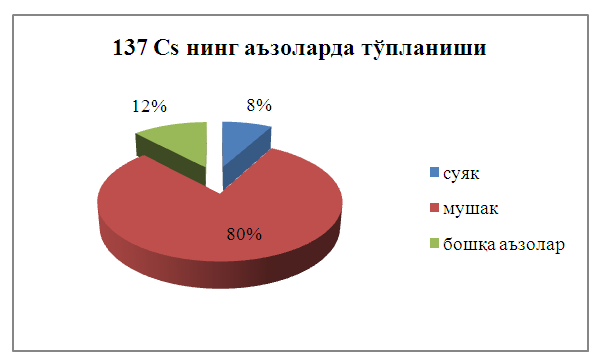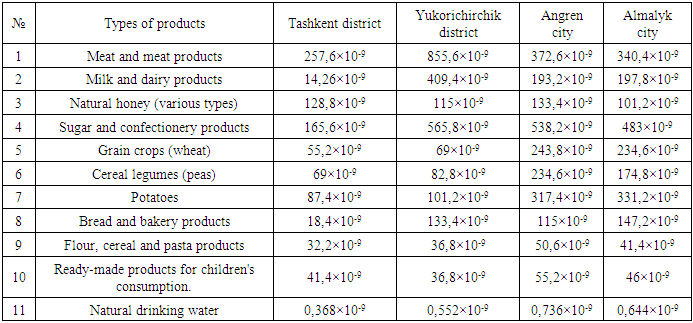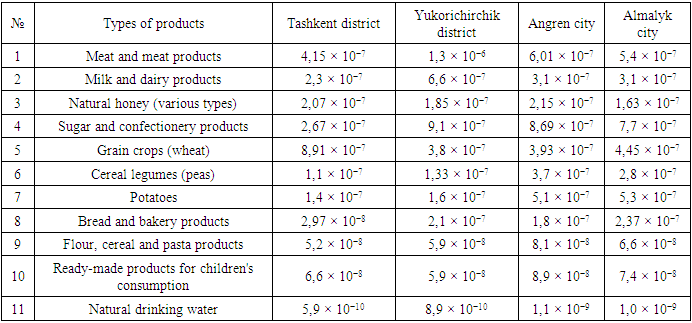-
Paper Information
- Next Paper
- Paper Submission
-
Journal Information
- About This Journal
- Editorial Board
- Current Issue
- Archive
- Author Guidelines
- Contact Us
American Journal of Medicine and Medical Sciences
p-ISSN: 2165-901X e-ISSN: 2165-9036
2023; 13(9): 1305-1308
doi:10.5923/j.ajmms.20231309.28
Received: Aug. 20, 2023; Accepted: Sep. 15, 2023; Published: Sep. 28, 2023

Contamination of Food Products with Caesium-137 in the Republic of Uzbekistan
Zaredinov D. A., Kodirov D. A., Israilova G. M.
Uz.R SSV, Center for the Development of Professional Qualifications of Medical Personnel
Copyright © 2023 The Author(s). Published by Scientific & Academic Publishing.
This work is licensed under the Creative Commons Attribution International License (CC BY).
http://creativecommons.org/licenses/by/4.0/

The safety of food products necessary for the population is one of the most urgent tasks facing the countries of the world. The problem of food security is multifaceted and includes political, social, economic and medical aspects. One of the main problems of food safety is to ensure its radioactive safety. Through this article, a radiological analysis of food products regularly consumed by the residents of Tashkent district, Yukorichirchik district, Angren and Olmalik cities of Tashkent region was deliberated. Food products were tested for cesium-137 radionuclide. According to the obtained results, the indicators of the cities of Angren and Almalyk were several times higher than those of the Tashkent district and Yukorichirchik district. Such a high output of indicators was explained by the proximity of mountain ranges to these areas, the presence of old mineral deposits and other reasons.
Keywords: Nutrition, Radionuclides, Cesium-137, Pollution, Food safety
Cite this paper: Zaredinov D. A., Kodirov D. A., Israilova G. M., Contamination of Food Products with Caesium-137 in the Republic of Uzbekistan, American Journal of Medicine and Medical Sciences, Vol. 13 No. 9, 2023, pp. 1305-1308. doi: 10.5923/j.ajmms.20231309.28.
1. Introduction
- The safety of food products necessary for the population is one of the most urgent tasks facing the countries of the world. The problem of food security is multifaceted and includes political, social, economic and medical aspects. In connection with the transition of the country to new political-economic (market) relations, in order to harmonize the national legislation in the fields of technical regulation, sanitary and phytosanitary measures and intellectual property protection with the requirements of the agreements of the World Trade Organization, and changes occurring in all aspects of human life in the last 10-15 years. This is one of the important and urgent tasks for the new Uzbekistan.In such complex conditions, the creation of large-scale agricultural products processing and storage enterprises, which are related to the production, storage, sale, and concern of food raw materials and food products, a new type of worker of the runescausing it to be created.In such complex conditions, the creation of large-scale processing and storage enterprises of agricultural products related to the production, storage, sale, and transportation of food raw materials and food products leads to the creation of new types of jobs.Proper and safe nutrition is the health and future of nations. Many countries, including the Republic of Uzbekistan, have adopted national nutrition policies that include food safety and water laws that provide strict control over food production, sale, and consumption. In such conditions, radiological control of food and water, regulation of the amount of radionuclides in food products and water is of main prophylactic value. [1,2].Radioactivity refers to the voluntary decay of the nuclei of certain chemical elements, resulting in the release of various radiations into the environment. The common feature of these radiations is that they have the ability to irradiate the atoms and molecules of the medium through which they pass, resulting in the formation of ions with different signs (+, -). Therefore, all such rays are called "ionizing radiations" (IN). The discovery of radioactivity make it possible to use a new type of energy, but at the same time there are negative aspects:- can cause environmental contamination with radionuclides,- many radiation accidents affecting living organisms can occur.Around the world, radioactive cesium-137 and strontium-90 are distributed in varying degrees in the environment, cycling with wind and precipitation. The first reason for environmental contamination with radioactive nuclides is the inexhaustible "reserve" of radionuclides released into the atmosphere as a result of nuclear weapons tests, and the second is various radioactive accidents. [3,4,5].Monitoring of radioactivity of environmental objects carried out in the Republic of Uzbekistan gives a general idea of the level of presence of radionuclides, and this is not enough to evaluate the real hygienic value.In terms of assessing the actual level of cesium-137 accumulation in food products in the districts of Tashkent region and their entry into the body, it has not attracted the attention of researchers until now. This situation has led to the lack of scientific basis for rational schemes of radiation-hygienic monitoring in the region (as in the whole region), which can lead to serious problems in the control system.Along with the level of radionuclides entering the organ system, the problem of determining the formation characteristics of the absorbed doses, their ratio, distribution between individual organs and tissues, and the correct assessment of the level of biological significance has become of special scientific interest and relevance [3].The accident at the Chernobyl nuclear power plant in 1986 and the Fukushima accident in 2011 were considered major nuclear accidents, which in turn had an impact on the whole world. In addition, there are many different mineral deposits, old mines and natural radioactive areas on the territory of Uzbekistan, and the probability of environmental radiation from such objects is high. This radioactive effect made us think about how radioactive substances affect the human body and the environment. [6-7].Purpose: to give a hygienic assessment of the activity of radionuclide cesium-137 in various food products.Research objects: various fruits, berries, vegetables, grain products, meat and meat products, milk and milk products, ready-made products for children's consumption, natural water, bread obtained from the districts of Tashkent region (Tashkent district, Urkochirchik district, Angren and Almalyk cities), flour, cereal, pasta products.Our study used data obtained from spectrometric analysis to identify and determine the activity of cesium-137. The total activity (OA) and specific activity (UA) of food and drinking water were measured with spectrometer MKGB-01 and radiometer UMF-2000, and a hygienic assessment was made by comparison with the hygienic norms of food safety 0366-19 - SanQvaM. [8-9].
2. Research Results
- Investigations were carried out with spectrometer MKGB-01 and radiometer UMF-2000. Using spectrometer MKGB-01, radionuclide cesium-137 was detected in fruits, berries, vegetables, grain products and meat and meat products, milk and milk products. The total α-activity level of natural drinking water was determined using a UMF-2000 radiometer. The data for 2020-2022, obtained as a result of the investigation, were presented in a systematized form.According to the research carried out in 2020-2022, it was found that all products contain cesium-137. First, the examination was carried out in the soil, and the results showed that the cesium-137 in the soil samples of Angren and Almalyk cities (45.0-37.8 Bq/kg) was higher than in the Tashkent district and Yukorichirchik districts (21.2-23.0 Bq/kg) (Table 1). After that, inspection work was carried out on food products. In the analysis of meat and meat products (186 Bq/kg), milk and milk products (89 Bq/kg) obtained from Yukorichirchik region of Tashkent region, it can be seen that cesium-137 radionuclide is close to the upper limit of normal values. In the analysis of grain crops, grain legumes and vegetable products (53-51-69 Bq/kg) from the cities of Angren and Almayk, it can be seen that the radionuclide of cesium-137 is close to the upper limit of the standard values, but these three types of products from the Yukorichirchik district (15-18-22 Bk/kg) indicators are low. In the analysis of all bread and bakery products, sugar and confectionery products (25-117 Bq/kg) from Angren, Almalyk cities, Yukorichirchik district, it can be seen that the cesium-137 radionuclide is close to the upper limit of normal values. However, it can be seen that the indicators of imported flour, groats, cereals, pasta and ready-made products for children's consumption (11-9 Bk/kg) and local natural honey (22-29 Bk/kg) are much lower. All the samples taken from the Tashkent district are much lower than the upper limit of the standard values (Table 2). Based on these obtained results, the average relative activity of the samples (Table 3) and the risk factor affecting the organ system (Table 4) were calculated and compared with the standard acceptable level of risk (Table 5).
|
|
|
|
|
3. Summary
- Scientific research carried out in the districts and cities of Tashkent region shows that: when soil and local food products were analyzed according to standards in Tashkent district, Yukurochirchik district, Angren city and Almalyk cities, the results of soil and food products of Angren and Almalyk cities were at the upper limit of the standard indicators. it is found that it is close, on the contrary, it can be seen that the results are relatively low in Tashkent district and Ukurochirchik district. This is explained by the presence of mountainous regions near the cities of Angren and Almalyk, the presence of industrial enterprises, and the abundance of mineral deposits. On the contrary, the low indicators in Tashkent district and Yukorichirchik district are explained by the absence of mountainous regions, the absence of large industrial enterprises, and the complete absence of mineral deposits. Despite the relatively high indicators in the cities of Angren and Almalyk, it was found that their risk factor is low.According to the study of the literature of Uzbekistan and abroad, 80% of the cesium-137 radionuclide accumulates in the muscles, 8% in the skeletal system, and 12% in all organs and tissues. This is because cesium-137, which is an analogue of calcium-40, is incorporated into organs and tissues and causes various diseases in those places. (1-diagram).
 | Diagram 1 |
 Abstract
Abstract Reference
Reference Full-Text PDF
Full-Text PDF Full-text HTML
Full-text HTML



